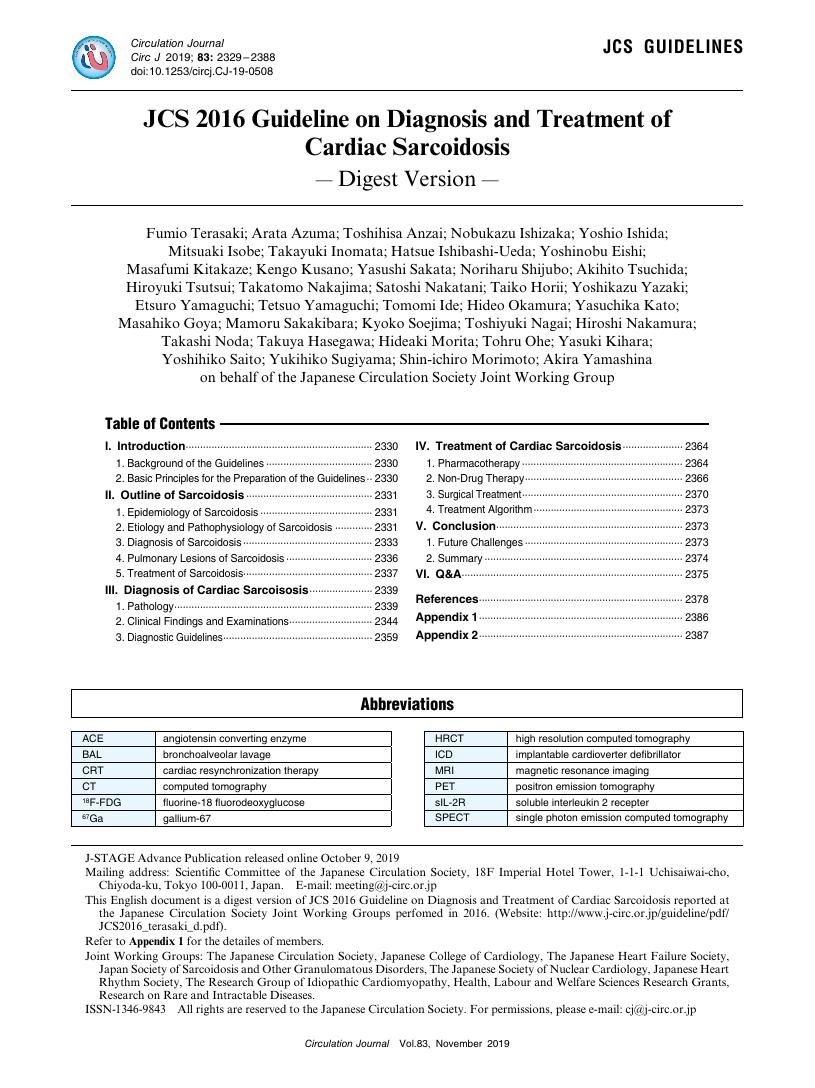- 著者
- Hideo Izawa Toshiko Yoshida Toshimi Ikegame Kazuhiro P. Izawa Yoshihiro Ito Hideo Okamura Naohiko Osada Shintaro Kinugawa Takuro Kubozono Yuji Kono Kiyonori Kobayashi Kazuhiko Nishigaki Taiki Higo Akihiro Hirashiki Yasushi Miyazawa Yuji Morio Masanobu Yanase Sumio Yamada Hisao Ikeda Shin-ichi Momomura Yasuki Kihara Kazuhiro Yamamoto Yoichi Goto Shigeru Makita the Japanese Association of Cardiac Rehabilitation Standard Cardiac Rehabilitation Program Planning Committee
- 出版者
- The Japanese Circulation Society
- 雑誌
- Circulation Journal (ISSN:13469843)
- 巻号頁・発行日
- pp.CJ-19-0670, (Released:2019-11-09)
- 参考文献数
- 21
- 被引用文献数
- 52
- 著者
- Fumio Terasaki Arata Azuma Toshihisa Anzai Nobukazu Ishizaka Yoshio Ishida Mitsuaki Isobe Takayuki Inomata Hatsue Ishibashi-Ueda Yoshinobu Eishi Masafumi Kitakaze Kengo Kusano Yasushi Sakata Noriharu Shijubo Akihito Tsuchida Hiroyuki Tsutsui Takatomo Nakajima Satoshi Nakatani Taiko Horii Yoshikazu Yazaki Etsuro Yamaguchi Tetsuo Yamaguchi Tomomi Ide Hideo Okamura Yasuchika Kato Masahiko Goya Mamoru Sakakibara Kyoko Soejima Toshiyuki Nagai Hiroshi Nakamura Takashi Noda Takuya Hasegawa Hideaki Morita Tohru Ohe Yasuki Kihara Yoshihiko Saito Yukihiko Sugiyama Shin-ichiro Morimoto Akira Yamashina on behalf of the Japanese Circulation Society Joint Working Group
- 出版者
- The Japanese Circulation Society
- 雑誌
- Circulation Journal (ISSN:13469843)
- 巻号頁・発行日
- vol.83, no.11, pp.2329-2388, 2019-10-25 (Released:2019-10-25)
- 参考文献数
- 355
- 被引用文献数
- 95 243
3 0 0 0 OA ジャスダック新規公開株の長期パフォーマンスと「半年効果」
- 著者
- 岡村 秀夫 Hideo Okamura
- 雑誌
- 商学論究 (ISSN:02872552)
- 巻号頁・発行日
- vol.59, no.4, pp.55-71, 2012-03-05
- 著者
- Hideo Okamura Christopher J. McLeod Christopher V. DeSimone Tracy L. Webster Crystal R. Bonnichsen Martha Grogan Sabrina D. Phillips Heidi M. Connolly Naser M. Ammash Carole A. Warnes Paul A. Friedman
- 出版者
- 日本循環器学会
- 雑誌
- Circulation Journal (ISSN:13469843)
- 巻号頁・発行日
- vol.80, no.6, pp.1328-1335, 2016-05-25 (Released:2016-05-25)
- 参考文献数
- 37
- 被引用文献数
- 1 30
Background:The subcutaneous implantable cardioverter defibrillator (S-ICD) provides an attractive option for patients with congenital heart disease (CHD) in whom a transvenous defibrillator is contraindicated. Given the unusual cardiac anatomy and repolarization strain, the surface electrocardiogram (ECG) is frequently abnormal, potentially increasing the screen failure rate.Methods and Results:We prospectively screened 100 adult CHD patients regardless of the presence of clinical indication for ICD utilizing a standard left sternal lead placement, as well as a right parasternal position. Baseline patient and 12-lead ECG characteristics were examined to assess for predictors of screen failure. Average patient age was 48±14 years, average QRS duration was 134±37 ms, and 13 patients were pacemaker dependent. Using the standard left parasternal electrode position, 21 patients failed screening. Of these 21 patients with screen failure, 9 passed screening with the use of right parasternal electrode positioning, reducing screening failure rate from 21% to 12%. QT interval and inverted T wave anywhere in V2–V6 leads were found to be independent predictors of left parasternal screening failure (P=0.01 and P=0.04, respectively).Conclusions:Utilization of both left and right parasternal screening should be used in evaluation of CHD patients for S-ICD eligibility. ECG repolarization characteristics were also identified as novel predictors of screening failure in this group. (Circ J 2016; 80: 1328–1335)
